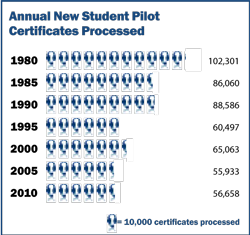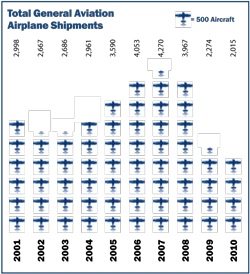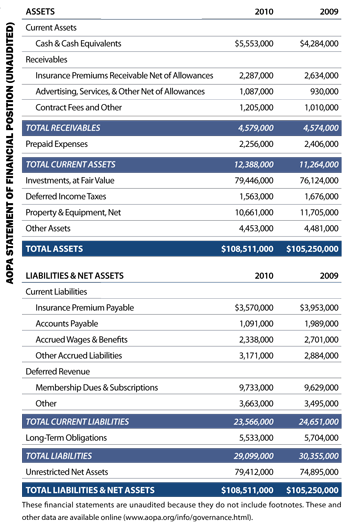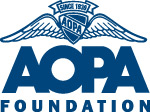These videos reflect the spirit of those who live, love, and work general aviation. Related photos accompanied this article in AOPA Pilot.
General aviation’s situation during 2010 was very much like flying in mountain wave conditions: We experienced both exhilarating updrafts and the occasional big downdraft, and we had to remain keenly alert for rising terrain—as well as changes in the weather. While those conditions are continuing into 2011, signs are pointing to improvement.

Photography on these pages reflect the spirit of the people who live, work, and love general aviation. For video stories that accompany many of these photos, visit AOPA Live.
Just the fact that those oscillations are damping provides some encouragement. After all, the nation is just now beginning to emerge from the worst economic crisis in 70 years. I don’t need to tell you that every sector of the American economy has been hit. General aviation is no exception, and neither are the individuals and businesses that use general aviation. The good news is that we are beginning to see real signs of recovery. Everywhere I go, pilots and aviation companies seem more optimistic than they have in a long while.
And there are some hard numbers indicating a turnaround, too. FAA statistics tell us that tower activity was up 10 percent from 2009 to 2010; center activity was up seven percent, and avgas sales were up one percent. We’re also seeing anecdotal evidence indicating companies that had set aside general aviation flying during the leanest times are getting their planes and people back in the sky—also a good trend.
Much of the growth so far is from existing pilots, flying their existing aircraft—and as a result, we see GA manufacturers lagging behind in this recovery. U.S. aircraft manufacturers have endured a devastating two years of plummeting sales and sagging order backlogs, and workforces have been reduced by as much as 50 percent. Yet GA generates one of the few positive trade balances of any industry; even in a down cycle, manufacturing can create $4.9 billion in exports. In fact, 60 percent of the billings for GA aircraft manufactured in 2010 were for exported aircraft.
Although we see the economy getting stronger, we also know that the government is facing massive deficits—not only at the federal level, but in states and local communities, too. And that has made budget cutting one of the dominant political themes this year. When lawmakers are looking for ways to reduce spending, general aviation is very often a convenient target. One of our challenges is making sure that well-intended cuts don’t have negative unintended consequences over the long term; for example, if a community closes its airport, that airport is gone for good—and the tax revenue promised by the alternative use of the site frequently doesn’t materialize.

It’s impossible to overlook what may be the greatest long-term challenge of all: the steady decline in the pilot population. The number of pilots has been falling for decades. And even from 2009 to 2010, we saw that trend continue. The number of private pilot certificates issued for the year was down 51 percent; the number of new commercial pilots fell 47 percent, the number of new CFIs dropped 13 percent, and the number of new instrument ratings was down 50 percent compared to the previous year. Those are numbers we need to do something about.
And AOPA is doing something about it—and about each of the challenges now facing general aviation. “Rally GA” is our theme this year, an idea that encapsulates our efforts to pull together all of our resources—not just AOPA’s resources, but also the resources of the entire GA community—to support general aviation and protect our freedom to fly. And there are many ways in which you can help.
Part of this effort is storytelling, if you will—telling stories that promote flying and spread the good that general aviation can accomplish. It also means we are working with our fellow aviation associations to tackle some of the big challenges facing us, like the future of avgas and what NextGen should look like. And it means we are rallying support in Congress so we will have allies who understand the importance and value of general aviation, and keep GA in mind when they are working through tough issues like FAA reauthorization, transportation priorities, and budgeting. In short, we want to be poised to take advantage of the updrafts along this mountainous course.

Flight training initiative. So, with that in mind, let’s talk about growing the pilot population. Every year as many as 80 percent of all people who start flight training drop out—without earning a certificate. I can’t think of a single endeavor where that would be considered acceptable, and it’s not acceptable for flight training, either. So what’s happening between the time people start their training and the time they either complete it or drop out? To find out, AOPA has launched the Flight Training Student Retention Initiative, partially funded by the AOPA Foundation. This major project is taking a detailed look at the training process, uncovering the hidden stumbling blocks, and talking with experts throughout the aviation industry to find ways that are both practical and effective to address those problems.
 We started this initiative last year with some very detailed research on the training process as it exists today. We also talked with student pilots, including those who have dropped out; flight instructors; flight school operators; and others. We found gaps between student expectations and the flight-instruction experience, and other issues that were raised consistently. The full report is available online. We brought together more than 100 experts from all areas of the aviation industry at AOPA’s Aviation Summit last November to share our research findings and begin to discuss solutions. We’re continuing that process this year, with a series of regional meetings scheduled at locations around the country. A Flight School Business e-newsletter for flight schools and CFIs, and additional online support for current students, also are part of this important initiative.
We started this initiative last year with some very detailed research on the training process as it exists today. We also talked with student pilots, including those who have dropped out; flight instructors; flight school operators; and others. We found gaps between student expectations and the flight-instruction experience, and other issues that were raised consistently. The full report is available online. We brought together more than 100 experts from all areas of the aviation industry at AOPA’s Aviation Summit last November to share our research findings and begin to discuss solutions. We’re continuing that process this year, with a series of regional meetings scheduled at locations around the country. A Flight School Business e-newsletter for flight schools and CFIs, and additional online support for current students, also are part of this important initiative.
If we’re successful in our effort to rally a broad base of industry stakeholders to make a significant—and sustainable—increase in the student-pilot completion rate, we’ll see a larger and more vibrant pilot population. Just a modest 1-percent increase in the student pilot completion rate would result in more than 500 new pilots each year.
NextGen. Another big issue facing us is NextGen—the FAA’s next generation air traffic control system. While we tend to think of NextGen in terms of ATC, NextGen is much more than that. It also encompasses a modernized infrastructure, and touches on policies, training, access to airspace, new technology, and new equipment, as well as the question of how to pay for it all.
AOPA is engaged at all levels of government to make certain that this critical initiative recognizes the needs of general aviation—and that GA users receive benefits that justify their costs of equipage. Along with leaders from other aviation organizations, the airlines, and the FAA, I sit on the NextGen Advisory Committee for RTCA, which develops consensus-based recommendations regarding communications, navigation, surveillance, and air traffic management system issues. Our group is charged with coming up with consensus recommendations for the FAA as to what NextGen should be and how we should get there.
As you can imagine, our priorities differ in some specific areas. Ultimately, however, what matters most to pilots, no matter what or why they fly, is the safety and efficiency of our aviation system. As the representative of the general aviation community, I want to make sure that there is parity in the system—that you have access to the airspace and to important information, whether you are flying a piston single, a twin turboprop, or an airliner. If we are successful, there are clear benefits for installing the necessary equipment in your aircraft. We are also looking at ways to make affording that equipment easier, such as the possibility of government-backed low-interest loans.

Avgas. Another area where we are really rallying GA is in the continuing search for a viable alternative to leaded avgas. AOPA has been working closely with other aviation organizations, the petroleum industry, and the FAA on the enormous task of transitioning to a new fuel that provides the safety, efficiency, performance, and pricing necessary to make it work for the general aviation community. We’ve seen some very promising developments, and this coalition has made great progress in establishing a process to identify and address issues.
More recently we’ve been working with Congress on language in the research and development section of the House FAA bill to authorize funding for avgas research. At the same time, we are working hard to make sure that we can continue to buy and fly with 100LL until an unleaded solution emerges. So, although this is an issue that will not be going away, it’s also not something to panic about.
Success will result from continued collaboration among critical players—including manufacturers, the FAA, and EPA—as the industry progresses toward an unleaded fuel.
 User fees and FAA funding. I’m very pleased to report that Congress continues to recognize the importance of providing stable, long-term FAA funding. In January, 116 members of the House signed a letter to President Obama opposing user fees. And when the president issued his budget proposal, we were encouraged to see that it did not include user fees. That’s right, no federal user fee was even proposed. Remember that as recently as two years ago, a proposed budget included $9.6 billion in fees. No new state taxes were imposed on general aviation in 2010, either, although several states tried. And that didn’t just happen. AOPA played a significant role at the state and federal levels in assuring that GA issues were considered, especially during these times when all levels of government are struggling to find new revenue sources.
User fees and FAA funding. I’m very pleased to report that Congress continues to recognize the importance of providing stable, long-term FAA funding. In January, 116 members of the House signed a letter to President Obama opposing user fees. And when the president issued his budget proposal, we were encouraged to see that it did not include user fees. That’s right, no federal user fee was even proposed. Remember that as recently as two years ago, a proposed budget included $9.6 billion in fees. No new state taxes were imposed on general aviation in 2010, either, although several states tried. And that didn’t just happen. AOPA played a significant role at the state and federal levels in assuring that GA issues were considered, especially during these times when all levels of government are struggling to find new revenue sources.
The budget proposal also protects Airport Improvement Program (AIP) funding for smaller airports, although it does propose cutting those funds for medium-sized and large hub airports. Matched with state and local funds, this money helps with the maintenance and expansion of airports across the country—protecting a vital national asset, our public-use airports.
During testimony before the House Transportation and Infrastructure Committee, I talked about NextGen and continuing efforts surrounding FAA reauthorization. I also spoke about the importance of maintaining our infrastructure, separate and apart from the investments we need to make in NextGen. For example, we don’t want to see AIP funds redirected to NextGen projects when those monies are needed for other vitally important projects like resurfacing or extending runways. Success here will be a multiyear reauthorization that gives the FAA the financial stability to keep NextGen moving forward and, at the same time, maintains a healthy general aviation infrastructure.
GA Caucuses. An accomplishment of which I am especially proud is the formation of general aviation caucuses in the House and Senate. Established through work with our colleagues in other aviation organizations, the caucuses help us to educate members of Congress on issues that are important to GA. These informal groups provide a wonderful way to Rally GA on Capitol Hill. The caucuses prove vital in increasing the understanding of general aviation among key members of Congress. Just having a forum to discuss and consider the issues is a big step toward building the kind of support that we need with lawmakers. After 2010’s exceptional growth, this is a rebuilding year for the caucuses. For example, the House GA Caucus ended 2010 with 124 members; this year, it had to be reestablished for the 112th Congress—and by early May had already grown to 101 members. Our success here ensures that new members of Congress understand the important economic contribution the GA community makes to the nation. Ask your senators and representative to participate!
 Getting involved. There are many areas where we really need pilots like you to be part of the “Rally GA” effort. We know we can count on you because of your high degree of engagement. After all, you contacted our Pilot Information Center and Member Services teams more than 320,000 times during 2010; enrollment in AOPA’s automatic annual membership renewal program has reached new heights, with more than half of the membership participating; and you’re flocking to our new AOPA Facebook page at an incredible rate.
Getting involved. There are many areas where we really need pilots like you to be part of the “Rally GA” effort. We know we can count on you because of your high degree of engagement. After all, you contacted our Pilot Information Center and Member Services teams more than 320,000 times during 2010; enrollment in AOPA’s automatic annual membership renewal program has reached new heights, with more than half of the membership participating; and you’re flocking to our new AOPA Facebook page at an incredible rate.
AOPA’s Airport Support Network volunteers serve as eyes and ears, monitoring developments around the airport and informing AOPA when a threat is identified. The ASN program counts more than 2,300 volunteers at airports across the nation.
All of us can share good-news stories, volunteer at our local airport, and respond to the call when AOPA seeks your help. You can also invite newcomers to give flying a try and help them through the training process—we have a website designed specifically to help, LetsGoFlying.com. If we hold a GA Serves America community event near you, please attend! Your presence at AOPA Aviation Summit, our highly engaging annual event, also sends a powerful message.
There are dozens of ways you can help as we Rally GA. Your involvement can make a real difference as we Rally GA and protect our freedom to fly. We’ve even created a special section on our website where you can get more ideas and find out about opportunities in your area. I hope you’ll join us. Regardless of how you participate, I know we can count on you to continue to act in support of GA.
Leveraging your membership. Last year saw AOPA’s first membership dues increase in nearly two decades, a modest increase of $6. Do you wonder how your dues can keep this diverse organization operating? The fact of the matter is that they don’t; your membership actually is worth much more.
 Even with the downturn in advertising revenue experienced in 2010, reflective of cost-cutting measures taken by businesses across the general aviation industry, advertising revenue generated by AOPA’s diverse media portfolio still makes a significant contribution of more than 17 percent to the association’s operating budget.
Even with the downturn in advertising revenue experienced in 2010, reflective of cost-cutting measures taken by businesses across the general aviation industry, advertising revenue generated by AOPA’s diverse media portfolio still makes a significant contribution of more than 17 percent to the association’s operating budget.
AOPA continues to diversify into new media, in order to address changing membership behavior and demand—and to meet those members where they are with respect to technology. Work in 2010 led to the launch early this year of Enhanced Digital Editions of AOPA Pilot and Flight Training magazines. These digital publications, which can be read on personal computers and many portable electronic devices, integrate the magazines’ world-class content with videos, slideshows, audio, and other rich media. Members can add a digital subscription or choose to receive one in place of their print publication.
Printed magazines certainly are not going away. Our media team continues to enhance AOPA Pilot and Flight Training. In fact, the newly redesigned Flight Training won several magazine awards this year. Our online video channel, AOPA Live, came into its own last year, streaming hours of live programming during AOPA Aviation Summit, EAA AirVenture, and now Sun ’n Fun. AOPA Live racked up some 1 million plays in 180 countries during 2010 and traffic in 2011 is on track to easily surpass that number. Other media products that offer compelling editorial content, and contribute advertising revenues, include AOPA Online, AOPA ePilot , Aviation eBrief , and AOPA Airports.
Your membership dues also are leveraged by revenue that is generated by AOPA’s financial programs, which include a credit card, aircraft financing, and insurance offerings; aircraft insurance policies sold by the AOPA Insurance Agency; and affinity programs with rental car companies and other travel service providers.
AOPA’s Member Products group launched several new products during 2010, including LifeLock, Lifeline Screenings, the Lifestyles Collection, and a new life insurance program. In addition, two new email newsletters were launched to inform members about benefit information, special offers, and other program news.
All of these products help us stretch your member dues by more than three times. In other words, without this additional revenue, your membership dues would need to more than triple in order to allow us to continue all of the work that we do on your behalf.
Our success in Washington, D.C.; with the states; and right down to your local airport depends on your support through your action and engagement, your renewed membership, and your support of our additional products and services. With your participation, we can maintain a healthy membership of more than 400,000 and continue to play a pivotal role in assuring a strong future for general aviation.

Craig L. Fuller
AOPA President and CEO

 One Strong Identity
One Strong Identity
ASF becomes ASI
Addressing challenges to general aviation requires money. The AOPA Foundation is AOPA's 501(c)(3) charitable organization. Money raised by the AOPA Foundation is tax-deductible and goes to support safety, education, and research programs. The AOPA Foundation focuses its efforts specifically on four areas that members have identified as critical to GA's future: protecting airports, restoring the pilot population, improving the image of general aviation, and enhancing GA safety.
To provide a unified brand identity and improve administrative efficiency, the AOPA Foundation merged with the AOPA Air Safety Foundation in October 2010. The former ASF is now the Air Safety Institute, a division of the AOPA Foundation; it provides all of the excellent safety information and products that ASF did—and continues to innovate with new offerings.
In 2010 the AOPA Air Safety Foundation and the AOPA Foundation provided $4.5 million in funding for safety and education programs; $400,000 for research and other support to help grow the pilot population; and $370,000 for projects that help to improve the image of GA. In addition to the Air Safety Institute's full line of safety education programs, funding plans this year include research and events to promote pilot-population growth; economic impact studies of general aviation airports to estimate the economic and demographic footprint of general aviation, and to examine what GA has added to the economy; and presentations to community groups, decision makers, media, and the general public about the importance of general aviation.
The AOPA Foundation increased its combined net assets by 13 percent in 2010. New initiatives include the "Friends of GA" monthly giving program and "A Night for Flight," a benefit and online auction held in conjunction with AOPA Aviation Summit.
The Air Safety Institute proudly continues its predecessor's tradition of producing targeted, effective safety information for all pilots. In 2010 ASI produced two live safety seminars, "Ten Things Other Pilots Do Wrong" and "Real World IFR," as well as five online courses—including ASI's landmark Flight Risk Evaluator. By simply entering information into this interactive online tool, a pilot can receive invaluable assistance in objectively evaluating the risk of a proposed flight, a key part of any go/no-go decision.
The institute also conducted six online webinars; produced 24 safety quizzes; and distributed a quarterly newsletter, CFI to CFI, in print and electronically to 90,000 flight instructors. In addition, ASI joined forces with the Palo Alto Airport Authority to present a one-time safety seminar in Palo Alto, California, to help mitigate unwanted negative perception of GA after a Cessna 310 crashed there in February 2010.
Those important safety-education messages reached pilots more than 1 million times, a three-percent increase over 2009. ASI set a new record with more than 475,000 course completions, a 13-percent increase, and the webinars drew nearly 13,000 participants. For 2011, ASI plans to introduce 10 online courses, two live safety seminars, eight webinars, and 24 safety quizzes, among other initiatives. In addition to those core products, ASI is working on several exciting new products that will diversify its safety education portfolio. It's important that we also explore new ways of communicating our safety message.

Bruce Landsberg
President, AOPA Foundation



